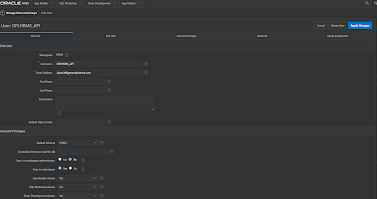1. First we need to create procedure which convert image to pdf. The procedure will like bellow.
CREATE OR REPLACE FUNCTION HRMS.PDF2IMAGE (p_blob IN BLOB)
RETURN CLOB
IS
l_clob CLOB;
l_step PLS_INTEGER := 24573;--12000;
-- make sure you set a multiple of 3 not higher than 24573
BEGIN
FOR i IN 0 .. TRUNC ( (DBMS_LOB.getlength (p_blob) - 1) / l_step)
LOOP
l_clob :=
l_clob
|| UTL_RAW.cast_to_varchar2 (
UTL_ENCODE.base64_encode (
DBMS_LOB.SUBSTR (p_blob, l_step, i * l_step + 1)));
END LOOP;
RETURN l_clob;
END;
2. We need to create sample query to bring data from database.
SELECT UNIQUE_ID, EMPLOYEE_NAME,
(SELECT CODE_DESC
FROM CODE_MASTER
WHERE HARD_CODE = 'DSG' AND SOFT_CODE = DESIGNATION_CODE)
|| CHR (10)
|| (SELECT CODE_DESC FROM CODE_MASTER WHERE HARD_CODE = 'CDV'
AND SOFT_CODE = COMPANY_DIVISION_ID)
|| CHR (10)
|| 'ID: '
|| UNIQUE_ID
|| CHR (10)
|| 'Blood Group: '
|| (SELECT CODE_DESC
FROM CODE_MASTER
WHERE HARD_CODE = 'BLD' AND SOFT_CODE = BLOOD_GROUP)
EMPLOYEE_DETAILS,
'Date of Issue: '
|| TO_CHAR (SYSDATE, 'DD.MM.RRRR')
|| CHR (10)
|| 'Date of Expire: '
|| TO_CHAR (ADD_MONTHS (SYSDATE, 24), 'DD.MM.RRRR')
ISSUE_DATE,
PDF2IMAGE (PICTURE) PICTURE
FROM EMPLOYEE_INFORMATION
WHERE UNIQUE_ID =:P464_UNIQUE_ID;
3. In BI Publisher Image Filed Properties change with Following code
<fo:instream-foreign-object content-type="image/jpg" height="1.2 in" width="1 in" border="1 in" border-color="blue" >
<xsl:value-of select="PICTURE"/>
</fo:instream-foreign-object>.
4. Image Resize Procedure.
CREATE OR REPLACE PROCEDURE HRMS.RESIZE_IMAGE (P_UNIQUE_ID NUMBER)
IS
V_PHOTO BLOB;
V_THUMD BLOB;
V_MIME_TYPE VARCHAR2 (200);
V_FILE_NAME VARCHAR2 (300);
V_IMAGE_SIZE NUMBER;
V_WIDTH NUMBER := 360;
V_HEIGHT NUMBER := 410;
BEGIN
SELECT TO_NUMBER (CEIL (SUM (DBMS_LOB.GetLength (picture) / 1024)))
INTO V_IMAGE_SIZE
FROM EMPLOYEE_INFORMATION
WHERE UNIQUE_ID = P_UNIQUE_ID;
IF V_IMAGE_SIZE > 20
THEN
SELECT PICTURE,
PICTURE,
MIME_TYPE,
FILENAME
INTO V_PHOTO,
V_THUMD,
V_MIME_TYPE,
V_FILE_NAME
FROM EMPLOYEE_INFORMATION
WHERE UNIQUE_ID = P_UNIQUE_ID
FOR UPDATE;
-----------Scale The Image Size
ORDSYS.ORDIMAGE.process (V_THUMD, 'maxScale=250 320');
ORDSYS.ORDIMAGE.process (V_PHOTO,
'maxScale=' || V_WIDTH || ' ' || V_HEIGHT);
UPDATE EMPLOYEE_INFORMATION
SET PICTURE = V_PHOTO,
MIME_TYPE = V_MIME_TYPE,
FILENAME = V_FILE_NAME
WHERE UNIQUE_ID = P_UNIQUE_ID;
END IF;
COMMIT;
END;
/







